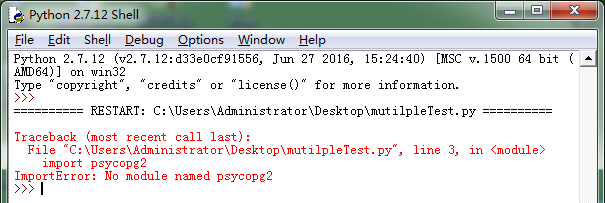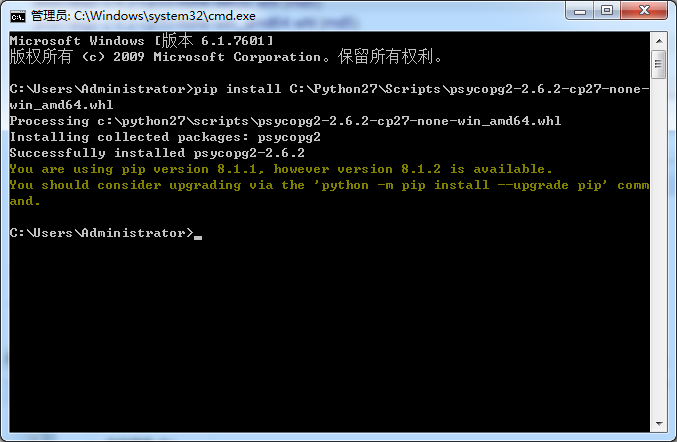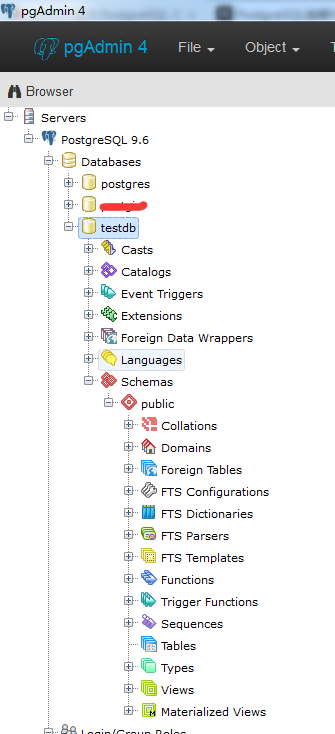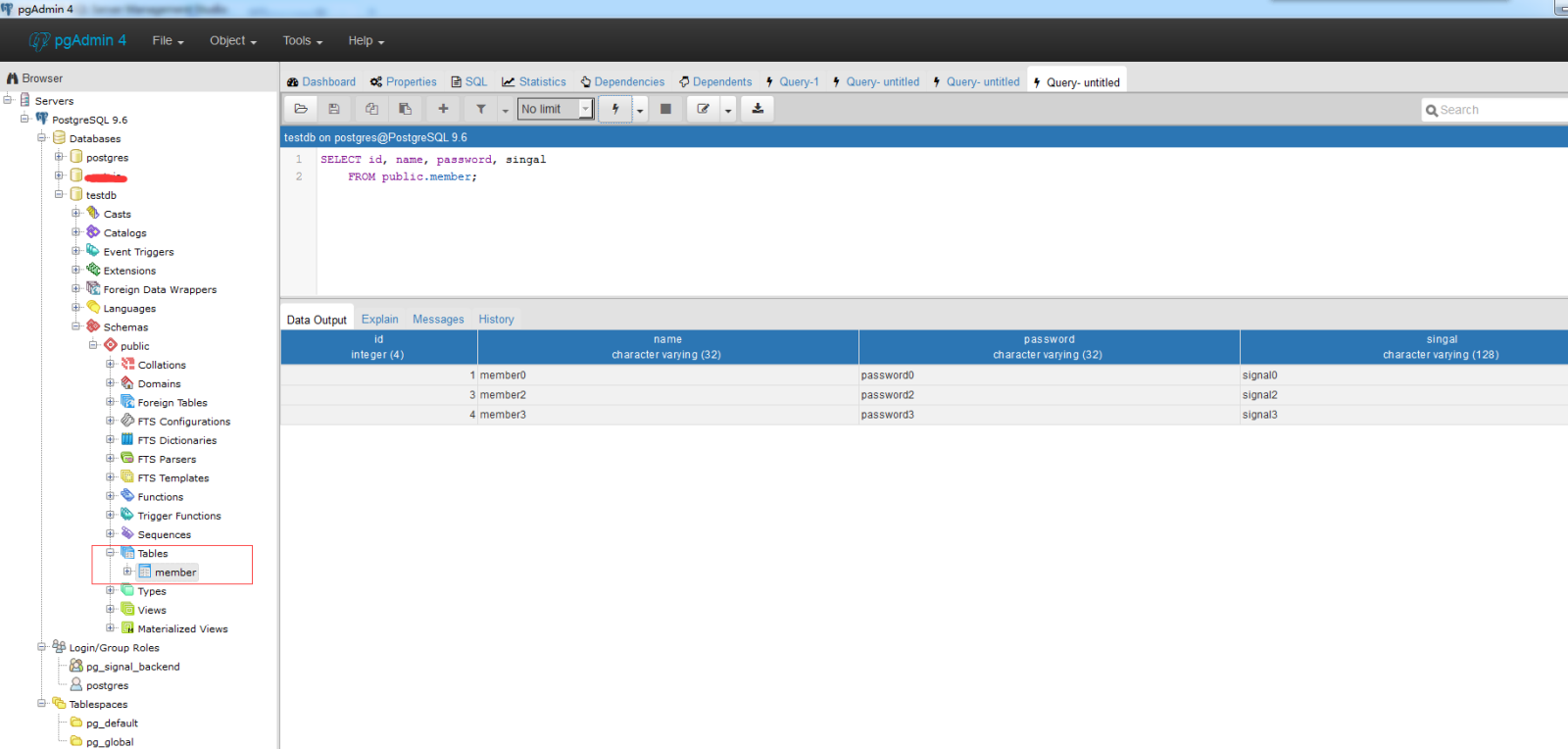其實在Python中可以用來連接PostgreSQL的模塊很多,這里比較推薦psycopg2。psycopg2安裝起來非常的簡單(pip install psycopg2),這里主要重點介紹下如何使用。
安裝psycopg2模塊:
怎么驗證是否已經安裝過psycopy2?

編寫上面代碼,運行看是否拋出缺少psycopg2模塊。

安裝方法1:
1)使用psycopg2-2.4.2.win-amd64-py2.7-pg9.0.4-release.exe安裝,下載地址:http://vdisk.weibo.com/s/Cd8pPaw56Ozys
直接運行exe,不出錯誤,運行上邊代碼驗證代碼無錯誤,基本算是安裝完成了。
2)怎么卸載?
2.1)找到安裝目錄:C:\Python27,發現下邊包含文件:Removepsycopg2.exe,運行,來刪除;
2.2)如果運行失敗的話,進入目錄:C:\Python27\Lib\site-packages下,找到psycopg2文件夾和psycopg2-2.4.2-py2.7.egg-info文件,右鍵刪除。
2.3)運行上邊的代碼,確認是否刪除成功。
安裝方法2:
使用.whl安裝,下載地址:https://pypi.python.org/pypi/psycopg2/

下載文件:psycopg2-2.6.2-cp27-none-win_amd64.whl
我這里把psycopg2-2.6.2-cp27-none-win_amd64.whl拷貝到安裝目錄下Scripts文件夾中。
cmd中運行代碼:pip install C:\Python27\Scripts\psycopg2-2.6.2-cp27-none-win_amd64.whl

運行上邊的代碼,確認是否刪除成功。
通過psycopg2操作數據庫:
使用賬戶postgres,創建測試數據庫testdb。

參考yiibai.comAPI:
S.N. API & 描述
1 psycopg2.connect(database="testdb", user="postgres", password="cohondob", host="127.0.0.1", port="5432")
這個API打開一個連接到PostgreSQL數據庫。如果成功打開數據庫時,它返回一個連接對象。
2 connection.cursor()
該程序創建一個光標將用于整個數據庫使用Python編程。
3 cursor.execute(sql [, optional parameters])
此例程執行SQL語句。可被參數化的SQL語句(即占位符,而不是SQL文字)。 psycopg2的模塊支持占位符用%s標志
例如:cursor.execute("insert into people values (%s, %s)", (who, age))
4 curosr.executemany(sql, seq_of_parameters)
該程序執行SQL命令對所有參數序列或序列中的sql映射。
5 curosr.callproc(procname[, parameters])
這個程序執行的存儲數據庫程序給定的名稱。該程序預計為每一個參數,參數的順序必須包含一個條目。
6 cursor.rowcount
這個只讀屬性,它返回數據庫中的行的總數已修改,插入或刪除最后 execute*().
7 connection.commit()
此方法提交當前事務。如果不調用這個方法,無論做了什么修改,自從上次調用commit()是不可見的,從其他的數據庫連接。
8 connection.rollback()
此方法會回滾任何更改數據庫自上次調用commit()方法。
9 connection.close()
此方法關閉數據庫連接。請注意,這并不自動調用commit()。如果你只是關閉數據庫連接而不調用commit()方法首先,那么所有更改將會丟失!
10 cursor.fetchone()
這種方法提取的查詢結果集的下一行,返回一個序列,或者無當沒有更多的數據是可用的。
11 cursor.fetchmany([size=cursor.arraysize])
這個例程中取出下一個組的查詢結果的行數,返回一個列表。當沒有找到記錄,返回空列表。該方法試圖獲取盡可能多的行所顯示的大小參數。
12 cursor.fetchall()
這個例程獲取所有查詢結果(剩余)行,返回一個列表。空行時則返回空列表。
打開數據庫連接:
|
1
2
3
4
5
6
7
8
|
import osimport sysimport psycopg2def connectPostgreSQL():conn = psycopg2.connect(database="testdb", user="postgres", password="new.1234", host="127.0.0.1", port="5432")print 'connect successful!'if __name__=='__main__':connectPostgreSQL() |
創建表操作:
|
1
2
3
4
5
6
7
8
9
10
11
12
13
14
15
16
17
18
|
import osimport sysimport psycopg2def connectPostgreSQL():conn = psycopg2.connect(database="testdb", user="postgres", password="new.1234", host="127.0.0.1", port="5432")print 'connect successful!'cursor=conn.cursor()cursor.execute('''create table public.member(id integer not null primary key,name varchar(32) not null,password varchar(32) not null,singal varchar(128))''')conn.commit()conn.close()print 'table public.member is created!'if __name__=='__main__':connectPostgreSQL() |
Insert 操作:
|
1
2
3
4
5
6
7
8
9
10
11
12
13
14
15
16
17
18
19
20
21
22
23
24
25
26
27
28
29
30
31
32
33
34
35
36
|
import os import sys import psycopg2 def connectPostgreSQL(): conn = psycopg2.connect(database="testdb", user="postgres", password="new.1234", host="127.0.0.1", port="5432") print 'connect successful!' cursor=conn.cursor() cursor.execute('''create table public.member( id integer not null primary key, name varchar(32) not null, password varchar(32) not null, singal varchar(128) )''') conn.commit() conn.close() print 'table public.member is created!' def insertOperate(): conn = psycopg2.connect(database="testdb", user="postgres", password="new.1234", host="127.0.0.1", port="5432") cursor=conn.cursor() cursor.execute("insert into public.member(id,name,password,singal)\ values(1,'member0','password0','signal0')") cursor.execute("insert into public.member(id,name,password,singal)\ values(2,'member1','password1','signal1')") cursor.execute("insert into public.member(id,name,password,singal)\ values(3,'member2','password2','signal2')") cursor.execute("insert into public.member(id,name,password,singal)\ values(4,'member3','password3','signal3')") conn.commit() conn.close() print 'insert records into public.memmber successfully' if __name__=='__main__': #connectPostgreSQL()insertOperate() |
Select 操作:
|
1
2
3
4
5
6
7
8
9
10
11
12
13
14
15
16
17
18
19
20
21
22
23
24
25
26
27
28
29
30
31
32
33
34
35
36
37
38
39
40
41
42
43
44
45
46
47
|
import os import sys import psycopg2 def connectPostgreSQL(): conn = psycopg2.connect(database="testdb", user="postgres", password="new.1234", host="127.0.0.1", port="5432") print 'connect successful!' cursor=conn.cursor() cursor.execute('''create table public.member( id integer not null primary key, name varchar(32) not null, password varchar(32) not null, singal varchar(128) )''') conn.commit() conn.close() print 'table public.member is created!' def insertOperate(): conn = psycopg2.connect(database="testdb", user="postgres", password="new.1234", host="127.0.0.1", port="5432") cursor=conn.cursor() cursor.execute("insert into public.member(id,name,password,singal)\ values(1,'member0','password0','signal0')") cursor.execute("insert into public.member(id,name,password,singal)\ values(2,'member1','password1','signal1')") cursor.execute("insert into public.member(id,name,password,singal)\ values(3,'member2','password2','signal2')") cursor.execute("insert into public.member(id,name,password,singal)\ values(4,'member3','password3','signal3')") conn.commit() conn.close() print 'insert records into public.memmber successfully' def selectOperate(): conn = psycopg2.connect(database="testdb", user="postgres", password="new.1234", host="127.0.0.1", port="5432") cursor=conn.cursor() cursor.execute("select id,name,password,singal from public.member where id>2") rows=cursor.fetchall() for row in rows: print 'id=',row[0], ',name=',row[1],',pwd=',row[2],',singal=',row[3],'\n' conn.close() if __name__=='__main__': #connectPostgreSQL() #insertOperate() selectOperate() |
結果:
|
1
2
3
4
5
6
7
8
9
|
Python 2.7.12 (v2.7.12:d33e0cf91556, Jun 27 2016, 15:24:40) [MSC v.1500 64 bit (AMD64)] on win32Type "copyright", "credits" or "license()" for more information.>>> ========== RESTART: C:\Users\Administrator\Desktop\mutilpleTest.py ==========id= 3 ,name= member2 ,pwd= password2 ,singal= signal2 id= 4 ,name= member3 ,pwd= password3 ,singal= signal3 >>> |
update操作:
|
1
2
3
4
5
6
7
8
9
10
11
12
13
14
15
16
17
18
19
20
21
22
23
24
25
26
27
28
29
30
31
32
33
34
35
36
37
38
39
40
41
42
43
44
45
46
47
48
49
50
51
52
53
54
55
56
57
58
59
60
61
|
import osimport sysimport psycopg2def connectPostgreSQL(): conn = psycopg2.connect(database="testdb", user="postgres", password="new.1234", host="127.0.0.1", port="5432") print 'connect successful!' cursor=conn.cursor() cursor.execute('''create table public.member(id integer not null primary key,name varchar(32) not null,password varchar(32) not null,singal varchar(128))''') conn.commit() conn.close() print 'table public.member is created!'def insertOperate(): conn = psycopg2.connect(database="testdb", user="postgres", password="new.1234", host="127.0.0.1", port="5432") cursor=conn.cursor() cursor.execute("insert into public.member(id,name,password,singal)\values(1,'member0','password0','signal0')") cursor.execute("insert into public.member(id,name,password,singal)\values(2,'member1','password1','signal1')") cursor.execute("insert into public.member(id,name,password,singal)\values(3,'member2','password2','signal2')") cursor.execute("insert into public.member(id,name,password,singal)\values(4,'member3','password3','signal3')") conn.commit() conn.close() print 'insert records into public.memmber successfully'def selectOperate(): conn = psycopg2.connect(database="testdb", user="postgres", password="new.1234", host="127.0.0.1", port="5432") cursor=conn.cursor() cursor.execute("select id,name,password,singal from public.member where id>2") rows=cursor.fetchall() for row in rows: print 'id=',row[0], ',name=',row[1],',pwd=',row[2],',singal=',row[3],'\n' conn.close()def updateOperate(): conn = psycopg2.connect(database="testdb", user="postgres", password="new.1234", host="127.0.0.1", port="5432") cursor=conn.cursor() cursor.execute("update public.member set name='update ...' where id=2") conn.commit() print "Total number of rows updated :", cursor.rowcount cursor.execute("select id,name,password,singal from public.member") rows=cursor.fetchall() for row in rows: print 'id=',row[0], ',name=',row[1],',pwd=',row[2],',singal=',row[3],'\n' conn.close() if __name__=='__main__': #connectPostgreSQL() #insertOperate() #selectOperate() updateOperate() |
結果:
|
1
2
3
4
5
6
7
8
9
10
11
12
13
14
|
Python 2.7.12 (v2.7.12:d33e0cf91556, Jun 27 2016, 15:24:40) [MSC v.1500 64 bit (AMD64)] on win32Type "copyright", "credits" or "license()" for more information.>>> ========== RESTART: C:\Users\Administrator\Desktop\mutilpleTest.py ==========Total number of rows updated : 1id= 1 ,name= member0 ,pwd= password0 ,singal= signal0 id= 3 ,name= member2 ,pwd= password2 ,singal= signal2 id= 4 ,name= member3 ,pwd= password3 ,singal= signal3 id= 2 ,name= update ... ,pwd= password1 ,singal= signal1 >>> |
Delete操作:
|
1
2
3
4
5
6
7
8
9
10
11
12
13
14
15
16
17
18
19
20
21
22
23
24
25
26
27
28
29
30
31
32
33
34
35
36
37
38
39
40
41
42
43
44
45
46
47
48
49
50
51
52
53
54
55
56
57
58
59
60
61
62
63
64
65
66
67
68
69
70
71
72
73
74
75
76
77
78
79
80
81
82
83
|
import osimport sysimport psycopg2def connectPostgreSQL(): conn = psycopg2.connect(database="testdb", user="postgres", password="new.1234", host="127.0.0.1", port="5432") print 'connect successful!' cursor=conn.cursor() cursor.execute('''create table public.member(id integer not null primary key,name varchar(32) not null,password varchar(32) not null,singal varchar(128))''') conn.commit() conn.close() print 'table public.member is created!'def insertOperate(): conn = psycopg2.connect(database="testdb", user="postgres", password="new.1234", host="127.0.0.1", port="5432") cursor=conn.cursor() cursor.execute("insert into public.member(id,name,password,singal)\values(1,'member0','password0','signal0')") cursor.execute("insert into public.member(id,name,password,singal)\values(2,'member1','password1','signal1')") cursor.execute("insert into public.member(id,name,password,singal)\values(3,'member2','password2','signal2')") cursor.execute("insert into public.member(id,name,password,singal)\values(4,'member3','password3','signal3')") conn.commit() conn.close() print 'insert records into public.memmber successfully'def selectOperate(): conn = psycopg2.connect(database="testdb", user="postgres", password="new.1234", host="127.0.0.1", port="5432") cursor=conn.cursor() cursor.execute("select id,name,password,singal from public.member where id>2") rows=cursor.fetchall() for row in rows: print 'id=',row[0], ',name=',row[1],',pwd=',row[2],',singal=',row[3],'\n' conn.close()def updateOperate(): conn = psycopg2.connect(database="testdb", user="postgres", password="new.1234", host="127.0.0.1", port="5432") cursor=conn.cursor() cursor.execute("update public.member set name='update ...' where id=2") conn.commit() print "Total number of rows updated :", cursor.rowcount cursor.execute("select id,name,password,singal from public.member") rows=cursor.fetchall() for row in rows: print 'id=',row[0], ',name=',row[1],',pwd=',row[2],',singal=',row[3],'\n' conn.close()def deleteOperate(): conn = psycopg2.connect(database="testdb", user="postgres", password="new.1234", host="127.0.0.1", port="5432") cursor=conn.cursor() cursor.execute("select id,name,password,singal from public.member") rows=cursor.fetchall() for row in rows: print 'id=',row[0], ',name=',row[1],',pwd=',row[2],',singal=',row[3],'\n' print 'begin delete' cursor.execute("delete from public.member where id=2") conn.commit() print 'end delete' print "Total number of rows deleted :", cursor.rowcount cursor.execute("select id,name,password,singal from public.member") rows=cursor.fetchall() for row in rows: print 'id=',row[0], ',name=',row[1],',pwd=',row[2],',singal=',row[3],'\n' conn.close() if __name__=='__main__': #connectPostgreSQL() #insertOperate() #selectOperate() #updateOperate() deleteOperate() |
結果:
|
1
2
3
4
5
6
7
8
9
10
11
12
13
14
15
16
17
18
19
20
21
22
|
Python 2.7.12 (v2.7.12:d33e0cf91556, Jun 27 2016, 15:24:40) [MSC v.1500 64 bit (AMD64)] on win32Type "copyright", "credits" or "license()" for more information.>>> ========== RESTART: C:\Users\Administrator\Desktop\mutilpleTest.py ==========id= 1 ,name= member0 ,pwd= password0 ,singal= signal0 id= 3 ,name= member2 ,pwd= password2 ,singal= signal2 id= 4 ,name= member3 ,pwd= password3 ,singal= signal3 id= 2 ,name= update ... ,pwd= password1 ,singal= signal1 begin deleteend deleteTotal number of rows deleted : 1id= 1 ,name= member0 ,pwd= password0 ,singal= signal0 id= 3 ,name= member2 ,pwd= password2 ,singal= signal2 id= 4 ,name= member3 ,pwd= password3 ,singal= signal3 >>> |

原文鏈接:http://blog.csdn.net/pcent/article/details/78643611










